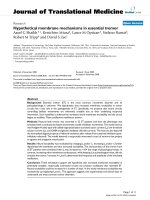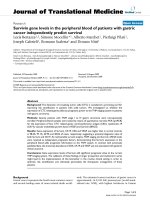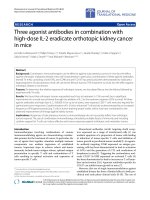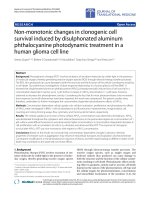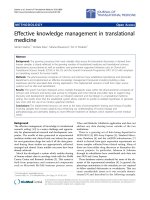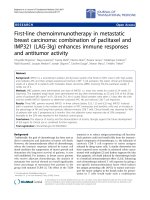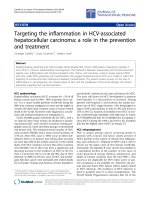báo cáo hóa học:" Tibial shaft fractures in football players" potx
Bạn đang xem bản rút gọn của tài liệu. Xem và tải ngay bản đầy đủ của tài liệu tại đây (356.68 KB, 5 trang )
BioMed Central
Page 1 of 5
(page number not for citation purposes)
Journal of Orthopaedic Surgery and
Research
Open Access
Research article
Tibial shaft fractures in football players
Winston R Chang*
†
, Zain Kapasi
†
, Susan Daisley
†
and William J Leach
Address: Department of Trauma and Orthopaedics, Western Infirmary, Glasgow, UK
Email: Winston R Chang* - ; Zain Kapasi - ; Susan Daisley - ;
William J Leach -
* Corresponding author †Equal contributors
Abstract
Background: Football is officially the most popular sport in the world. In the UK, 10% of the adult
population play football at least once a year. Despite this, there are few papers in the literature on
tibial diaphyseal fractures in this sporting group. In addition, conflicting views on the nature of this
injury exist. The purpose of this paper is to compare our experience of tibial shaft football fractures
with the little available literature and identify any similarities and differences.
Methods and Results: A retrospective study of all tibial football fractures that presented to a
teaching hospital was undertaken over a 5 year period from 1997 to 2001. There were 244 tibial
fractures treated. 24 (9.8%) of these were football related. All patients were male with a mean age
of 23 years (range 15 to 29) and shin guards were worn in 95.8% of cases. 11/24 (45.8%) were
treated conservatively, 11/24 (45.8%) by Grosse Kemp intramedullary nail and 2/24 (8.3%) with
plating. A difference in union times was noted, conservative 19 weeks compared to operative group
23.9 weeks (p < 0.05). Return to activity was also different in the two groups, conservative 27.6
weeks versus operative 23.3 weeks (p < 0.05). The most common fracture pattern was AO Type
42A3 in 14/24 (58.3%). A high number 19/24 (79.2%) were simple transverse or short oblique
fractures. There was a low non-union rate 1/24 (4.2%) and absence of any open injury in our series.
Conclusion: Our series compared similarly with the few reports available in the literature.
However, a striking finding noted by the authors was a drop in the incidence of tibial shaft football
fractures. It is likely that this is a reflection of recent compulsory FIFA regulations on shinguards as
well as improvements in the design over the past decade since its introduction.
Background
Football is officially the most popular sport in the world.
The Fédération Internationale de Football Association
(FIFA) estimates that there are 250 million licensed play-
ers in 204 countries with 1% participation at professional
level [1]. In the UK, it is estimated that about 10% of the
adult population play football at least once a year [2]. It is
therefore of considerable importance to the social fabric
of society especially in Glasgow where there are two derby
teams. Despite this, there are very few good papers in the
literature on the epidemiology of tibial shaft fractures in
this sporting group [3,4]. In addition, there are conflicting
views in the literature. One study described football-
related tibial diaphyseal fractures as low-velocity injuries,
and very rarely associated with severe soft tissue damage
[4]. Other studies [5,6], suggest that lower leg fractures in
footballers are serious and potentially high-energy inju-
ries. Nevertheless an interesting observation is that studies
Published: 13 June 2007
Journal of Orthopaedic Surgery and Research 2007, 2:11 doi:10.1186/1749-799X-2-11
Received: 7 March 2006
Accepted: 13 June 2007
This article is available from: />© 2007 Chang et al; licensee BioMed Central Ltd.
This is an Open Access article distributed under the terms of the Creative Commons Attribution License ( />),
which permits unrestricted use, distribution, and reproduction in any medium, provided the original work is properly cited.
Journal of Orthopaedic Surgery and Research 2007, 2:11 />Page 2 of 5
(page number not for citation purposes)
carried out in the late 80's and early 90's had relatively
higher numbers [3,4], as compared to recent studies
where numbers are noted to be relatively lower [5,6]. This
may be a subtle hint of a decrease in the incidence of these
fractures.
We herein present our experience over a five year period
of tibial shaft football fractures in an attempt to identify
similarities and differences with the little available litera-
ture on this common sport.
Methods
The casenotes for all tibial fractures treated between 1997
and 2001 inclusive at the Western Infirmary, Glasgow
were identified using the hospital "Patient Administration
System". Of these, those arising as a result of a football
injury were retrospectively studied. Their casenotes and
radiographs were reviewed to establish the mechanism of
injury, type of fracture, treatment modality and their out-
come. A standardized data extraction proforma was used
to compile this data. All radiographs were classified
according to the AO/ASIF classification system (table 1).
The anatomic location of a fracture is designated by two
numbers, one for the bone and one for its segment. Each
long bone has three segments: the proximal, the diaphy-
seal, and the distal segment (figure 1). The malleolar seg-
ment is an exception and is classified as the fourth
segment of the tibia/fibula (44-). Tibial diaphyseal frac-
tures were therefore defined as AO Type 42 diaphyseal
fractures excluding the proximal and distal metaphyseal
regions (figure 1). The radiographs were analyzed by a sin-
gle person (third author) to eliminate the possibility of
any interobserver variability. Follow up data were col-
lected by telephone questionnaire.
Fracture union was defined as pain-free weight-bearing
without support; and bridging callus seen on 2 radio-
graphs taken at 90 degrees to each other. Delayed union
and non-union were defined as absence of callus on radi-
ographs at 4 and 6 months respectively [6].
The independent t-test was used for statistical analysis of
the results and a p value of less than 0.05 was considered
significant.
Results
In the 5 years period from 1997 to 2001, there were 244
tibial fractures treated. 24 (9.8%) of these were football
related. Of these, 3 were professional soccer players and
21 amateurs. All patients were male with a mean age of 23
years (range 15 to 29). The right tibia was fractured in
91.7% (22 patients) and the left in 8.3%. The mechanism
of injury in almost all cases, 23/24 (95.8%), involved
direct contact. Shinguards were also worn in 95.8% of
cases. 14 cases (58.3%) occurred on a weekend whilst 10
cases (41.7%) occurred on a weekday.
Fracture classification
Both tibia and fibula were fractured in 22/24 (91.7%)
cases whilst 2 (8.3%) involved the tibia only. There were
The four long bones and their segments [12]Figure 1
The four long bones and their segments [12].
Table 1: AO/ASIF classification of tibia shaft fractures [4]
Type Fracture Subclassification
A Simple A1 – spiral
A2 – oblique
A3 – transverse
B Wedge B1 – spiral wedge
B2 – bending wedge
B3 – fragmented wedge
C Complex C1 – spiral
C2 – segmental
C3 – irregular
AO/ASIF, Arbeitsgemeinschaft Osteosynthesefragen/Association for the study of Internal Fixation.
Journal of Orthopaedic Surgery and Research 2007, 2:11 />Page 3 of 5
(page number not for citation purposes)
no open injuries. The fracture types by AO classification
are summarized in Table 2.
Mode of Treatment
11/24 (45.8%) patients were treated conservatively. A
standard regimen was followed in the conservative group
which consisted of a non-weight bearing above knee plas-
ter for 8 weeks followed by a Sarmiento cast with partial
weight bearing until union occurred. The average in-
patient time was 2.4 days (range 2–4 days). Mean time to
fracture union was 19 weeks (standard deviation 4.05
weeks). The mean length of time taken to return to activ-
ity/training was 27.6 weeks (standard deviation 4.54
weeks).
The remaining patients, 13/24 (54.2%), were treated
operatively with 11/24 (45.8%), treated with a Grosse
Kemp intramedullary nail according to the manufacturer's
instructions with primary locking in all cases. The remain-
ing 2 cases were treated with open reduction and internal
fixation using a DCP plate and screws (closed 42A1); and
interfragmentary screws (43A1) respectively. All patients
who underwent intramedullary nailing were allowed par-
tial weight bearing for the first 6 weeks, followed by full
weight bearing as tolerated until union. The mean time
from admission to fixation was 20.9 hrs (range 3 to 39
hrs). Inpatient time averaged 3.7 days (range 2 to 6 days).
Mean time to union was 23.9 weeks (standard deviation
3.99 weeks). Despite this however, the average time to
return to training/activity was slightly quicker at 23.3
weeks (standard deviation 6.46 weeks).
The differences in time to union (p < 0.005) and return to
activity (p < 0.05) between those treated conservatively
and operatively were found to be significant
Complications
In total, there were 10 cases with complications summa-
rized in Table 4. Loss of position was the most common
complication amongst the conservatively treated group 4/
11 (36.4%). However, in one case the fibula was intact,
whilst another was a professional football player. All were
converted to an intramedullary nail. Only one fracture in
the conservative group did not unite and required open
reduction and internal plating with bone grafting and
fibulectomy and was lost to follow up.
Amongst the operatively treated group, anterior knee pain
was the most common complication, 3/13 (23.1%). One
patient (42B2) whose fixation interval was 23 hours had
respiratory complications related to fat embolism that
required supportive care and observation in the intensive
care unit for 2 days. Dynamisation was carried out in one
case that subsequently united at 9 months.
No patients in either group developed compartment syn-
drome.
Discussion
Our experience shows notable similarities and differences
when compared with the few reports available in the liter-
ature on such a widely played sport [5,3,4]. The most
common fracture pattern was the transverse AO Type
42A3 in 14/24 (58.3%). A high number 19/24 (79.2%)
were simple transverse or short oblique fractures. This is
consistent with the mechanism of injury involving a direct
blow (figure 2) and low-velocity as well as with previous
attempts to define the "footballer's fracture". Cattermole
et al [3] reported a direct blow in 95% of cases and our
finding mirrors this (95.8%). In fact, further support for
this is shown by the low non-union rate 1/24 (4.2%) and
the absence of an open injury in our series. The Edinburgh
Table 3: Treatments used according to AO fracture type.
AO fracture type Cast Intramedullary nail Plate and screws
A1 1 0 2
A2 2 3 0
A3 7 7 0
B1 1 0 0
B2 0 1 0
Total 11 11 2
Table 2: Summary of tibial shaft football fractures according to AO type.
Simple type Number Wedge type Number
A1 3 B1 1
A2 5 B2 1
A3 14 B3 0
Total 22 Total 2
Journal of Orthopaedic Surgery and Research 2007, 2:11 />Page 4 of 5
(page number not for citation purposes)
study found that 95.4% were closed injuries and of these
90% were Tscherne type 0 or 1 [4]. Delayed union and
non-union were also found to be low both by the Leicester
study and Lenehan et al quoted a 2% incidence [7]. The
latter simply reflects the 'personality' of the tibial fracture
as coined by Nicol in 1964 [8] as well as the low mean age
of the study population.
Union times were noted to be quicker in the conservative
group (p < 0.005). This may be a reflection of the self-
selecting bias of those fractures treated by intramedullary
nailing. Whilst the majority of fractures in both treatment
groups were A2 and A3, of these, the more displaced and
hence more severe ones would have been treated by nail-
ing.resulting in the longer healing time. This again is a
reflection of the personality of each fracture. On the other
hand, return to activity was earlier in the operative group
(p < 0.05), a well recognized fact [9]. It facilitates earlier
mobilization, hence preservation of muscle mass and pre-
vention of joint stiffness. which would otherwise be
present after treatment in a cast.
A striking finding in our study is the much lower inci-
dence of football fractures amongst all tibial shaft frac-
tures 24/244 (9.8%). The Edinburgh study period was
from 1988 to 1990 with an incidence of 24.7% [4] whilst,
Leeds looked at the period from 1990 to 1994 and quoted
an incidence of 17.6% [6]. This corresponded to an intro-
duction of shinguards by FIFA in 1990 as part of the com-
pulsory basic equipment of a player [10]. Shin guards
protect by spreading loads over wider areas of the skin.
The force of the initial impact is reduced as peak pressure
is dampened down. Over the past decade there have been
improvements in shinguards since its introduction. Fran-
cisco et al tested 23 commercially available shinguards
and found that they reduced force by 11% to 17% and
strain by 45% to 51% compared with the unguarded leg
[11]. The introduction of shinguards with its design
improvements may explain the lower incidence in our
most recent of all previous study periods (1997 to 2001).
In fact, shinguards were worn in 95.8% of cases which tes-
tified to its current widespread usage.
Conclusion
The nature and pattern of tibial shaft football fractures in
our series compared similarly with previously published
series. One exception noted however, was a decreasing
trend in the incidence of tibial football fractures. A possi-
ble explanation for this may have been the introduction of
shin-pads and improvement in their designs.
Competing interests
The authors declare that they have no competing interests.
No benefits in any form have been received or will be
received from a commercial party related directly or indi-
rectly to the subject of this article.
Table 4: Summary of complications of tibial shaft football fractures according to treatment method and their outcomes.
AO Class Treatment Complication Outcome
Closed 42A2 Cast Position slipped at day 12 IM nail. Nail was removed at 13 months because of anterior knee pain.
Closed 42A3 (fibula intact) Cast Position slipped at day 9 IM nail
Closed 42A2 Cast Position slipped at day 28 IMnail
Closed 42A3 Cast Position slipped at 8 IM nail
Closed 42A3 Cast Non-union at 5 months Underwent bone grafting and plating plus fibulectomy. Subsequently lost to follow-up.
Closed 42A3 IM nail Anterior knee pain Nail removed at 29 months
Closed 42A3 IM nail Delayed union Dynamisation at 24 weeks
Closed 42A3 IM nail Anterior knee pain Nail removed at 24 weeks
Closed 42B2 IM nail (at 23 hrs) Fat embolism Admitted to Intensive Care for 2 days then discharged on day 8 post-op. Fracture
subsequently united.
Closed 42A2 IM nail Anterior and medial knee pain. Self-discharged from clinic and lost to follow-up.
This picture demonstrates an example of the typical mecha-nism of injury involving a direct blow that results in a tibial fractureFigure 2
This picture demonstrates an example of the typical mecha-
nism of injury involving a direct blow that results in a tibial
fracture.
Publish with BioMed Central and every
scientist can read your work free of charge
"BioMed Central will be the most significant development for
disseminating the results of biomedical research in our lifetime."
Sir Paul Nurse, Cancer Research UK
Your research papers will be:
available free of charge to the entire biomedical community
peer reviewed and published immediately upon acceptance
cited in PubMed and archived on PubMed Central
yours — you keep the copyright
Submit your manuscript here:
/>BioMedcentral
Journal of Orthopaedic Surgery and Research 2007, 2:11 />Page 5 of 5
(page number not for citation purposes)
Authors' contributions
The first three authors contributed to the planning, execu-
tion and completion of the project. The article was written
up by the first author with advice and guidance from the
fourth (senior) author who conceptualized the topic of
this article. All authors read and approved the manuscript.
References
1. Stamm H, Lamprecht M: Big count: football 2000 worldwide:
official FIFA survey. Zurich: FIFA; 2001.
2. Matheson J: Participation in sport: a study carried out on
behalf of the Department of the Environment as part of the
1987 General Household Survey. In OPCS Social Survey Division,
Series GHS Volume 17. London: HMSO; 1991.
3. Cattermole HR, Hardy JWR, Gregg PJ: The footballer's fracture.
British Journal of Sports Medicine 1996, 30:171-5.
4. Shaw AD, Gustillo T, Court-Brown CM: Epidemiology and out-
come of tibial diaphyseal fractures in footballers. Injury 1997,
28:365-7.
5. Boden BP, Lohnes Jh, Nunley JA, Garrett WE: Tibia and fibula frac-
tures in soccer players. Knee Surg Sports Traumatol Arthrosc 1999,
7(4):262-6.
6. Templeton PA, Farrar MJ, Williams HR, Bruguera J, Smith RM: Com-
plications of tibial shaft soccer fractures. Injury 2000,
31:415-19.
7. Lenehan B, Fleming P, Walsh S, Kaar K: Tibial shaft fractures in
amateur footballers. British Journal of Sports Medicine 2003,
37:176-78.
8. Nicoll EA: Fractures of the tibial shaft. A survey of 705 cases.
JBJS(Br) 1964, 46:373-387.
9. Canale ST, (ed): Campbell's operative orthopaedics. Mosby 10th
edition. 2003, 3:2754-756.
10. International Football Association Board. Law IV. In History of
the laws of the game An official FIFA publication; 2003.
11. Francisco AC, Nightingale RW, Guilak F, Glisson RR, Garrett WE Jr:
Comparison of soccer shin guards in preventing tibia frac-
ture. Am J Sports Med 2000, 28(2):227-33.
12. Müller ME, Nazarian S, Koch P, Schatzker J, Heim U: The compre-
hensive classification of fractures of long bones. In Berlin Hei-
delberg New York: Springer-Verlag; 1990.

